
New boat-shaped robot mimics insects and is made of fish food
A new boat-shaped robot mimics the movement of fish and aquatic insects by using the Marangoni effect to glide across water surfaces. This phenomenon, driven by changes in surface tension, propels the robot forward through a chemical reaction.
A tiny chamber releases carbon dioxide gas, pushing fuel through a channel. The fuel reduces surface tension, causing the robot to advance.
Non-toxic and biodegradable design
The robot’s propulsion method employs a safe, biodegradable combination of citric acid and sodium bicarbonate – the same reaction found in school science experiments.
Propylene glycol, commonly used in skincare products, serves as the fuel. The design ensures minimal environmental impact while allowing the robot to move freely across the water surface for several minutes.
“While the development of miniature swimming robots for natural environments has progressed rapidly, these typically rely on plastics, batteries, and other electronics, which pose challenges for mass deployment in sensitive ecosystems,” says EPFL PhD student Shuhang Zhang.
“In this work, we show how those materials can be replaced by completely biodegradable and edible components.”
Fish food-powered robot
The robot is about 5 cm (2 inches) long and is made using fish food that has more protein and less fat than regular fish feed.
This design not only gives the robot a strong, sturdy body but also makes it edible for fish and other aquatic animals once its mission is over.
The body is created using a freeze-drying process, which removes moisture while keeping the structure lightweight and strong.
This method also prevents the robot from soaking up too much water, helping it stay buoyant and maintain its shape while moving.
Environmental monitoring potential
The EPFL team envisions deploying the robots in large numbers to collect environmental data, including water pH, temperature, and pollutant levels.
Equipped with biodegradable sensors, the devices could gather data remotely or through direct collection.
Instead of precise directional control, the researchers created “left turning” and “right turning” variants by adjusting the fuel channel’s design.

The robots’ pseudo-random movements mimic those of insects, making them suitable for delivering nutrients or medication to fish.
The design also includes a fluidic actuator to house the fuel and reaction chamber, which is activated when water contacts the chamber’s bottom membrane.
Advancing edible robotics
The Laboratory of Intelligent Systems has previously explored edible robotic systems. Past projects include edible soft actuators, fluidic circuits for edible computation, and conductive ink for crop monitoring.
“The replacement of electronic waste with biodegradable materials is the subject of intensive study, but edible materials with targeted nutritional profiles and function have barely been considered, and open up a world of opportunities for human and animal health,” says Dario Floreano, head of the laboratory and coordinator of the RoboFood consortium.
The RoboFood project, launched in 2021 with € 3.5 million ($3.8 million USD) in EU funding, continues to explore the potential of these devices in environmental and nutritional applications.
Fuel and motion analysis
The researchers selected propylene glycol as the fuel due to its high solubility and low toxicity.
Lecithin, though a safer surfactant, saturated the water surface quickly, reducing motion duration. The fluidic actuator design maximizes fuel capacity, allowing motion for several minutes before fuel depletion.
The propulsion system achieves a speed range of 0.5 to 3 body lengths per second, aligning with typical prey speeds in aquatic habitats.
This motion variability aids in distributing nutrients or medication while simulating natural prey behavior, potentially attracting predatory fish.
Robots offer new solutions for fish farming
The edible aquatic robot can function as a mobile environmental sensor or a nutrient delivery system for fish. Its design also allows for the integration of edible sensors, making it suitable for large-scale deployment in aquatic monitoring.
Further research could look into how these robots could be used in fish farming and the pet industry. They could be designed to provide specific nutrients, boost fish health, or even stimulate natural hunting behaviors in pet fish.
The biodegradable design also makes them suitable for delivering nutrients or medication in delicate ecosystems without causing harm or disrupting aquatic life.
Click here to watch a video demonstration…
The study is published in the journal Nature Communications.
—–
Like what you read? Subscribe to our newsletter for engaging articles, exclusive content, and the latest updates.
Check us out on EarthSnap, a free app brought to you by Eric Ralls and Earth.com.
—–













